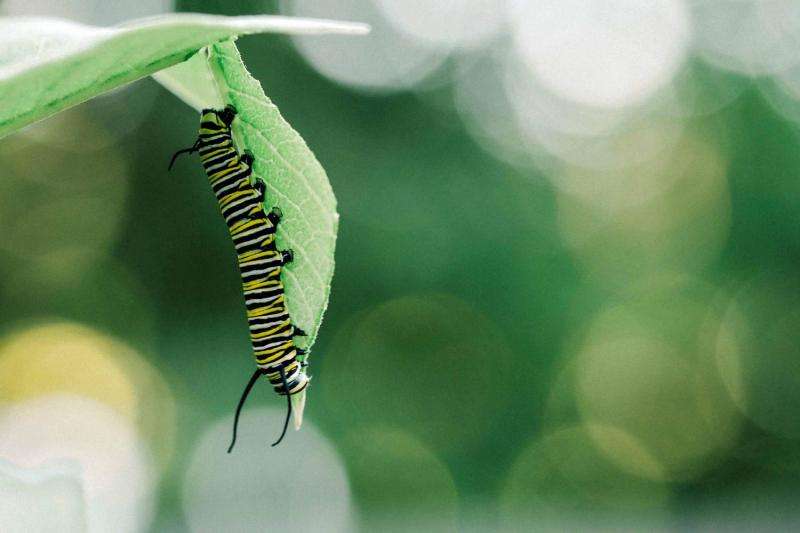Credit: Michigan State University
A year ago, the Howe lab developed a plant that upended a common misconception that plants can defend or grow, but not both. Theirs could.
As part of this work, they designed a plant with higher defense capabilities against pests. Ian Major, a post-doc in the Howe lab, wanted to understand what made it special.
Because, knowing how plants defend against caterpillars and other herbivores could help us develop tougher crops.
The USDA estimates that annual US crop losses to pests are significant, with some estimates showing up to 79 percent in lost harvest. And annual pesticide use is in the hundreds of millions of pounds, a financial drain with potential harmful effects to the environment.
And in a new study, published in the journal New Phytologist, Ian shows us that the genes involved with plant growth and defense are more tangled than previously thought.
Plant defense: restraint and release
Genes make things work in living beings. But there are also genes whose job is to prevent things from working.
Plant defenses use both types - and for good reason. They work a bit like a ref and a fighter.
"Plants normally have a set of genes that prevent defenses from turning on when they are not in danger," Ian says. "That saves energy."
But when a plant detects a caterpillar munching on a leaf, the defense restraint is removed.
With the restraint gone, genes, called MYCs, are unleashed and turn on the defenses, producing molecules that give caterpillars the equivalent of indigestion. That is enough to stop most from finishing their meal.
In previous work, the Howe lab removed the restraints to see what it was like to have a plant constantly on guard.
"This constantly defended plant grows almost as large as its wild cousins, which might seem encouraging, especially if we think about agricultural uses," Ian says. "But removing the restraint also upset many aspects of the plant's growth and development."
Fighters do more than just fight
"Observing the unleashed MYCs firing off defenses at all times showed us that they control seemingly unrelated plant developmental processes," Ian says.
Plant defense molecules can benefit human health. Credit: stevepb/Public Domain
And the way to examine that was to remove the MYCs and see how the plant reacted.
The result, produced by former lab member Yuki Yoshida, was a plant with eight genes knocked out. "It is a special person that would see that through. You need determination and patience to do it. It is rather impressive."
Without MYCs, plant defenses went offline, which was expected (the tell: the insects that fed on it grew fatter).
But other things showed up. Without MYCs, the plant's leaves and roots grew faster than normal, and the rates of photosynthesis were a bit higher.
"I think that these MYCs are bona fide growth controllers themselves – they seem to slow it down. We are still not sure how the MYCs do it all."
Into evolution and biotech apps
Taking out plant genes that are responsible for both repressing and activating defenses is a unique way to study how the genes work, Ian says.
"This approach has revealed things we wouldn't otherwise see. Typically, you wound a plant and study its response over time, which is an indirect approach."
But using genetic approaches to remove the genes cuts to the heart of the matter, because they reveal extreme responses, almost immediately.
These methods could help us understand defense strategies in a wider range of plants. Because, how plants control their defenses against insects tends to be similar across all terrestrial plants.
"When plants emerged from the ocean, this type of defense starts appearing in mosses and then evolves further. You can imagine that, once on land, plants had to adapt to new enemies."
In itself, this is encouraging to scientists who want to create or breed more resistant crops.
But there's more: many defense molecules that are harmful to caterpillars turn out to be useful for us.
"Take flavonoids, they are antioxidants for humans. Other defense compounds are used in chemotherapy drugs. Then there are substances like nicotine, caffeine, or morphine. All these are managed by similar plant defense mechanisms."
Currently, some pharmaceuticals are harvested from plant cell cultures grown and treated in laboratories. "Perhaps we could someday grow entire plants, stimulate their defenses, and then harvest some compound for mass production."
The benefits seem endless. But one thing is sure: the more we dig into plant defenses – and MYCs are just one part of a much larger puzzle - the more complex their picture looks.
More information: Ian T. Major et al. Regulation of growth-defense balance by the JASMONATE ZIM-DOMAIN (JAZ)-MYC transcriptional module, New Phytologist (2017). DOI: 10.1111/nph.14638
Journal information: New Phytologist
Provided by Michigan State University
























